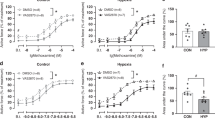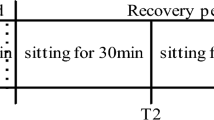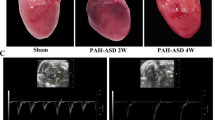Abstract
Aim:
To investigate the effects of exhaustive swimming exercise on P2X1 receptor- and α1-adrenoceptor-mediated vasoconstriction of different types of arteries in rats.
Methods:
Male Wistar rats were divided into 2 groups: the sedentary control group (SCG) and the exhaustive swimming exercise group (ESEG). The rats in the ESEG were subjected to a swim to exhaustion once a day for 2 weeks. Internal carotid, caudal, pulmonary, mesenteric arteries and aorta were dissected out. Isometric vasoconstrictive responses of the arteries to α,β-methylene ATP (α,β-MeATP) or noradrenaline (NA) were recorded using a polygraph.
Results:
The exhaustive swimming exercise did not produce significant change in the EC50 values of α,β-MeATP or NA in vasoconstrictive response of most of the arteries studied. The exhaustive swimming exercise inhibited the vasoconstrictive responses to P2X1 receptor activation in the internal carotid artery, whereas it reduced the maximal vasoconstrictive responses to α1-adrenoceptor stimulation in the caudal, pulmonary, mesenteric arteries and aorta. The rank order of the reduction of the maximal vasoconstriction was as follows: mesenteric, pulmonary, caudal, aorta.
Conclusion:
Exhaustive swimming exercise differentially affects the P2X1 receptor- and α1-adrenoceptor-regulated vasoconstriction in internal carotid artery and peripheral arteries. The ability to preserve purinergic vasoconstriction in the peripheral arteries would be useful to help in maintenance of the basal vascular tone during exhaustive swimming exercise.
Similar content being viewed by others
Log in or create a free account to read this content
Gain free access to this article, as well as selected content from this journal and more on nature.com
or
References
Kingwell BA . Nitric oxide-mediated metabolic regulation during exercise: effects of training in health and cardiovascular disease. FASEB J 2000; 14: 1685–96.
Sutoo D, Akiyama K . Regulation of brain function by exercise. Neurobiol Dis 2003; 13: 1–14.
Larson EB, Wang L . Exercise, aging, and Alzheimer disease. Alzheimer Dis Assoc Disord 2004; 18: 54–6.
Sastre J, Asensi M, Gasco E, Pallardo FV, Ferrero JA, Furukawa T, et al. Exhaustive physical exercise causes oxidation of glutathione status in blood: prevention by antioxidant administration. Am J Physiol 1992; 263: R992–5.
Banerjee AK, Mandal A, Chanda D, Chakraborti S . Oxidant, antioxidant and physical exercise. Mol Cell Biochem 2003; 253: 307–12.
Fehrenbach E, Northoff H . Free radicals, exercise, apoptosis, and heat shock proteins. Exerc Immunol Rev 2001; 7: 66–89.
Huang CC, Lin TJ, Chen CC, Lin WT . Endurance training accelerates exhaustive exercise-induced mitochondrial DNA deletion and apoptosis of left ventricle myocardium in rats. Eur J Appl Physiol 2009; 107: 697–706.
Aslani A, Babaee Bigi MA, Moaref AR, Aslani A . Effect of extreme exercise on myocardial function as assessed by tissue Doppler imaging. Echocardiography 2009; 26: 1036–40.
Howard MG, DiCarlo SE, Stallone JN . Acute exercise attenuates phenylephrine-induced contraction of rabbit isolated aortic rings. Med Sci Sports Exerc 1992; 24: 1102–7.
Chen Hi H, Chiang IP, Jen CJ . Exercise training increases acetylcholine-stimulated endothelium-derived nitric oxide release in spontaneously hypertensive rats. J Biomed Sci 1996; 3: 454–60.
Graham DA, Rush JW . Exercise training improves aortic endothelium-dependent vasorelaxation and determinants of nitric oxide bioavailability in spontaneously hypertensive rats. J Appl Physiol 2004; 96: 2088–96.
Moien-Afshari F, Ghosh S, Elmi S, Khazaei M, Rahman MM, Sallam N, et al. Exercise restores coronary vascular function independent of myogenic tone or hyperglycemic status in db/db mice. Am J Physiol Heart Circ Physiol 2008; 295: H1470–80.
Korzick DH, Laughlin MH, Bowles DK . Alterations in PKC signaling underlie enhanced myogenic tone in exercise-trained porcine coronary resistance arteries. J Appl Physiol 2004; 96: 1425–32.
Boarder MR, Hourani SM . The regulation of vascular function by P2 receptors: multiple sites and multiple receptors. Trends Pharmacol Sci 1998; 19: 99–107.
Collo G, North RA, Kawashima E, Merlo-Pich E, Neidhart S, Surprenant A, et al. Cloning of P2X5 and P2X6 receptors and the distribution and properties of an extended family of ATP-gated ion channels. J Neurosci 1996; 16: 2495–507.
Galligan JJ, Hess MC, Miller SB, Fink GD . Differential localization of P2 receptor subtypes in mesenteric arteries and veins of normotensive and hypertensive rats. J Pharmacol Exp Ther 2001; 296: 478–85.
Vial C, Evans RJ . P2X(1) receptor-deficient mice establish the native P2X receptor and a P2Y6-like receptor in arteries. Mol Pharmacol 2002; 62: 1438–45.
Erlinge D, Burnstock G . P2 receptors in cardiovascular regulation and disease. Purinergic Signal 2008; 4: 1–20.
Haddock RE, Hill CE . Sympathetic overdrive in obesity involves purinergic hyperactivity in the resistance vasculature. J Physiol 2011; 589: 3289–307.
Vidal M, Hicks PE, Langer SZ . Differential effects of alpha-beta-methylene ATP on responses to nerve stimulation in SHR and WKY tail arteries. Naunyn Schmiedebergs Arch Pharmacol 1986; 332: 384–90.
Thomas DP, Marshall KI . Effects of repeated exhaustive exercise on myocardial subcellular membrane structures. Int J Sports Med 1988; 9: 257–60.
Peijie C, Hongwu L, Fengpeng X, Jie R, Jie Z . Heavy load exercise induced dysfunction of immunity and neuroendocrine responses in rats. Life Sci 2003; 72: 2255–62.
Sun B, Wang JH, Lv YY, Zhu SS, Yang J, Ma JZ . Proteomic adaptation to chronic high intensity swimming training in the rat heart. Comp Biochem Physiol Part D Genomics Proteomics 2008; 3: 108–17.
Li L, Jia ZH, Chen C, Wei C, Han JK, Wu YL, et al. Physiological significance of P2X receptor-mediated vasoconstriction in five different types of arteries in rats. Purinergic Signal 2011; 7: 221–9.
Wihlborg AK, Slätt J, Sun X, Zhao XH, Malmsjö M, Bergman J, et al. 2,2′-Nitrophenylisatogen potentiates P2X1 receptor mediated vascular contraction and blood pressure elevation. Drug Dev Res 2003; 59: 82–7.
Jansakul C, Hirunpan P . Effects of exercise training on responsiveness of the mesenteric arterial bed to phenylephrine and KCl in male rats. Br J Pharmacol 1999; 127: 1559–66.
Jansakul C . Effect of swimming on vascular reactivity to phenylephrine and KCl in male rats. Br J Pharmacol 1995; 115: 587–94.
Yen MH, Yang JH, Sheu JR, Lee YM, Ding YA . Chronic exercise enhances endothelium-mediated dilation in spontaneously hypertensive rats. Life Sci 1995; 57: 2205–13.
Johnson LR, Parker JL, Laughlin MH . Chronic exercise training improves ACh-induced vasorelaxation in pulmonary arteries of pigs. J Appl Physiol 2000; 88: 443–51.
Johnson LR, Rush JW, Turk JR, Price EM, Laughlin MH . Short-term exercise training increases ACh-induced relaxation and eNOS protein in porcine pulmonary arteries. J Appl Physiol 2001; 90: 1102–10.
Goret L, Reboul C, Tanguy S, Dauzat M, Obert P . Training does not affect the alteration in pulmonary artery vasoreactivity in pulmonary hypertensive rats vasoreactivity in pulmonary hypertensive rats. Eur J Pharmacol 2005; 527: 121–8.
Izawa T, Morikawa M, Mizuta T, Nagasawa J, Kizaki T, Oh-ishi S, et al. Decreased vascular sensitivity after acute exercise and chronic exercise training in rat thoracic aorta. Res Commun Mol Pathol Pharmacol 1996; 93: 331–42.
Chies AB, de Oliveira AM, Pereira FC, de Andrade CR, Correa FM . Phenylephrine-induced vasoconstriction of the rat superior mesenteric artery is decreased after repeated swimming. J Smooth Muscle Res 2004; 40: 249–58.
Carter RW, Begaye M, Kanagy NL . Acute and chronic NOS inhibition enhances alpha(2)- adrenoreceptor-stimulated RhoA and Rho kinase in rat aorta. Am J Physiol Heart Circ Physiol 2002; 283: H1361–9.
Nori S, Fumagalli L, Bo X, Bogdanov Y, Burnstock G . Coexpression of mRNAs for P2X1, P2X2, and P2X4 receptors in rat vascular smooth muscle: an in situ hybridization and RT-PCR study. J Vasc Res 1998; 35: 179–85.
Ralevic V, Burnstock G . Receptors for purines and pyrimidines. Pharmacol Rev 1998; 50: 413–92.
Hansen MA, Dutton JL, Balcar VJ, Barden JA, Bennett MR . P2X (purinergic) receptor distributions in rat blood vessels. J Auton Nerv Syst 1999; 75: 147–55.
Wallace A, Knight GE, Cowen T, Burnstock G . Changes in purinergic signalling in developing and ageing rat tail artery: importance for temperature control. Neuropharmacology 2006; 50: 191–208.
Brake AJ, Wagenbach MJ, Julius D . New structural motif for ligand-gated ion channels defined by an ionotropic ATP receptor. Nature 1994; 371: 519–23.
Yang XP, Chiba S . Effects of a selective neuropeptide Y Y(1) receptor antagonist BIBP 3226 on double peaked vasoconstrictor responses to periarterial nerve stimulation in canine splenic arteries. Br J Pharmacol 2000; 130: 1699–705.
Sugawara J, Komine H, Hayashi K, Yoshizawa M, Otsuki T, Shimojo N, et al. Reduction in alpha-adrenergic receptor-mediated vascular tone contributes to improved arterial compliance with endurance training. Int J Cardiol 2009; 135: 346–52.
Dalsgaard MK, Quistorff B, Danielsen ER, Selmer C, Vogelsang T, Secher NH . A reduced cerebral metabolic ratio in exercise reflects metabolism and not accumulation of lactate within the human brain. J Physiol 2004; 554: 571–8.
Volianitis S, Fabricius-Bjerre A, Overgaard A, Stromstad M, Bjarrum M, Carlson C, et al. The cerebral metabolic ratio is not affected by oxygen availability during maximal exercise in humans. J Physiol 2008; 586: 107–12.
Cheng XW, Kuzuya M, Kim W, Song HZ, Hu L, Inoue A, et al. Exercise training stimulates ischemia-induced neovascularization via phosphatidylinositol 3-kinase/Akt-dependent hypoxia-induced factor-1 alpha reactivation in mice of advanced age. Circulation 2010; 122: 707–16.
Maiorana AJ, Naylor LH, Exterkate A, Swart A, Thijssen DH, Lam K, et al. The impact of exercise training on conduit artery wall thickness and remodeling in chronic heart failure patients. Hypertension 2011; 57: 56–62.
Acknowledgements
This work was supported by a grant from the National Program on Key Basic Research Project of China (973 Program) (No 2005CB523301).
Author information
Authors and Affiliations
Corresponding authors
Rights and permissions
About this article
Cite this article
Li, L., Wu, T., Wei, C. et al. Exhaustive swimming differentially inhibits P2X1 receptor- and α1-adrenoceptor-mediated vasoconstriction in isolated rat arteries. Acta Pharmacol Sin 33, 221–229 (2012). https://doi.org/10.1038/aps.2011.148
Received:
Accepted:
Published:
Issue date:
DOI: https://doi.org/10.1038/aps.2011.148
Keywords
This article is cited by
-
Comparison of mRNA Expression of P2X Receptor Subtypes in Different Arterial Tissues of Rats
Biochemical Genetics (2020)
-
(−)Doxazosin is a necessary component for the hypotensive effect of (±)doxazosin during long-term administration in conscious rats
Acta Pharmacologica Sinica (2014)



